by Admin user
Jul 08 2025
The Art of Watering: How to Master Moisture for Healthy Plant Growth
The Art of Watering: How to Master Moisture for Healthy Plant Growth
Category: Plant Care & Cultivation
Watering may seem like the simplest gardening task, but it’s actually one of the most critical—and often misunderstood—elements of plant care. Both overwatering and underwatering can damage roots, stunt growth, and invite disease. In this guide, we’ll dig into the best practices for watering plants, tailored to different species, environments, and seasons. Whether you're managing a commercial nursery or a home garden, mastering the art of moisture management will elevate your plant health and overall success.
Understanding Plant Water Needs
Each plant species has its own hydration profile. Some thrive in drought-like conditions, while others require consistently moist soil.
- Research Your Plants: Learn the native habitat of your species. Succulents, for example, store water and prefer dry conditions, while ferns need steady moisture.
- Growth Stage Matters: Young plants and seedlings need more frequent watering to establish roots. Mature plants may tolerate longer intervals.
- Container vs Ground: Potted plants dry out faster due to limited soil volume. Monitor them closely, especially in warm climates.
Optimal Watering Techniques
Good watering is about timing, method, and consistency. Poor habits—like splashing water on leaves during midday heat—can harm plants more than help them.
- Water Early Morning or Late Evening: These times minimize evaporation and allow water to soak deeply.
- Target the Roots: Focus water at the base. Avoid spraying foliage unless you're combating pests or dust.
- Deep Watering Over Frequency: Thorough, less frequent watering encourages roots to grow downward, making plants more resilient.
- Avoid Waterlogging: Ensure soil has proper drainage. Sitting water leads to root rot and fungal issues.
Seasonal Adjustments
Just as plants change with the seasons, so should your watering strategy.
- Spring: Increase watering gradually as temperatures rise. Watch for early drought signs in newly planted specimens.
- Summer: Increase frequency, especially for vegetables and flowering species. Mulching helps retain moisture.
- Autumn: Begin reducing water as growth slows. Avoid stimulating new growth before winter.
- Winter: Water sparingly, especially for dormant plants. Ensure roots are hydrated, but do not saturate cold soil.
Signs of Watering Mistakes
Identifying early symptoms helps correct watering issues before irreversible damage sets in.
- Overwatering: Yellowing leaves, mushy stems, and fungal spots often indicate excess moisture.
- Underwatering: Wilting, dry soil, and browning leaf edges signal dehydration.
- Root Stress: Check for root curling or rot during transplanting—it can reflect past watering habits.
Tools and Techniques to Level Up
Modern tools simplify the process and increase precision.
- Soil Moisture Meters: Ideal for high-value plants or large-scale nurseries.
- Drip Irrigation Systems: Saves water and delivers consistent hydration directly to roots.
- Self-Watering Pots: Great for busy gardeners or delicate indoor plants.
- Rainwater Collection: Natural, unchlorinated water reduces chemical exposure and supports sustainability.
Final Thoughts
Water is more than a necessity—it’s a relationship. Understanding how plants respond to hydration helps you tailor your care with wisdom and patience. From seasonal tweaks to species-specific needs, a mindful watering strategy is the backbone of healthy, flourishing greenery. Whether you’re guiding clients at your nursery or cultivating your personal garden, remember: the best gardens aren’t overwatered, they’re well observed.

comment 1
user 08 Jul 2025
vert helpfull blog save alot of my time and solve my problem of watering my plants